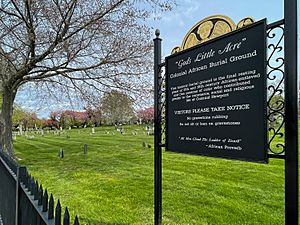Common Burying Ground and Island Cemetery facts for kids
Quick facts for kids |
|
|
Common Burying Ground and Island Cemetery
|
|
 |
|
| Lua error in Module:Location_map at line 420: attempt to index field 'wikibase' (a nil value). | |
| Location | Newport, Rhode Island |
|---|---|
| Area | 31 acres (13 ha) |
| Built | 1640 |
| Architectural style | Beaux Arts, Romanesque |
| NRHP reference No. | 74000044 |
| Added to NRHP | May 1, 1974 |
The Common Burying Ground and Island Cemetery are two old cemeteries in Newport, Rhode Island. They are located on Farewell and Warner Street. Together, these cemeteries hold over 5,000 graves. This includes a special section for enslaved people from the colonial era. There are also graves for Jewish people. These two cemeteries were added to the National Register of Historic Places in 1974. This means they are important historical sites.
Contents
History of the Cemeteries
The Common Burying Ground started in 1640. It was built on land given to Newport by John Clarke. This cemetery has many colonial-era gravestones. It has the most colonial African American gravestones in the United States. The northern part of the cemetery is mostly for African Americans. Local people often call this area "God's Little Acre."
The city of Newport created the Island Cemetery in 1836. In 1848, a private group called the Island Cemetery Corporation took it over. Many important families from Newport are buried here.
Lost Gravestones Found
Sometimes, old gravestones get lost. But in 2016, three lost gravestones were found! One small stone for a 1-year-old child was found in Pennsylvania. Two other stones from 1835 were found in a Newport yard. They were put back in the Common Burying Ground.
In 2017, two more burial stones were found in Pennsylvania. These belonged to Violet and Duchess Quamino. Duchess Quamino was a free Black woman. She was once enslaved by William Ellery Channing. She was an active member of Newport's African community. These stones were also returned and fixed.
Famous People Buried Here
Many important people are buried in these cemeteries. They include governors, artists, and heroes.
Common Burying Ground Heroes
- William Ellery (1727–1820): He signed the Declaration of Independence. He was also a colonial Deputy Governor.
- James Franklin (1697–1735): He was a printer. He was also the older brother of Benjamin Franklin.
- Ann Smith Franklin (1696–1763): She was a printer and publisher. She was the first woman in the U.S. to edit a newspaper.
- Ida Lewis (lighthouse keeper) (1842–1911): She was a famous lighthouse keeper. She saved many lives. She received the Gold Lifesaving Medal.
- Duchess Quamino (1739–1804): She was known as the "Pastry Queen of Rhode Island." She was a formerly enslaved woman.
- Gilbert Stuart (1755–1828): He was a famous portrait artist. He painted George Washington.
Island Cemetery Notables
- August Belmont (1816–1890): He was a rich financier. He started the Belmont Stakes horse race.
- George T. Downing (1819–1903): He was an abolitionist. This means he worked to end slavery. He was also an entrepreneur and restaurateur.
- Richard Morris Hunt (1827–1895): He was a famous architect. He designed many grand buildings.
- Charles Bird King (1785–1862): He was a painter.
- Clarence King (1842–1901): He was a geologist.
- Matthew C. Perry (1794–1858): He was a Commodore in the Navy. He led the "Black Ships Expedition" to Japan in 1853.
- Oliver Hazard Perry (1785–1819): He was a hero of the War of 1812. He won the Battle of Lake Erie.
- Hazard Stevens (1842–1918): He was a Civil War general. He received the Medal of Honor.
- Isaac Ingalls Stevens (1818–1862): He was a Civil War general. He was killed in action.
- Gouverneur K. Warren (1830–1882): He was a key engineer in the Civil War. He helped at the Battle of Gettysburg.
Images for kids
-
Original grave slab for Governor John Cranston on left, and newer slab for both him and his son, Governor Samuel Cranston, on right
-
Table marker for Governor Samuel Ward on left; brick vault for his father, Governor Richard Ward, on right
-
Enclosed plot for Deputy Governor William Ellery, signer of the Declaration of Independence
-
William Ellery grave inscription
-
Grave plaque for William Ellery
See also
- Touro Cemetery, the old Jewish cemetery at Newport
- Coddington Cemetery, where six colonial Rhode Island governors are buried
- Clifton Burying Ground, where four colonial Rhode Island governors are buried
- National Register of Historic Places listings in Newport County, Rhode Island















